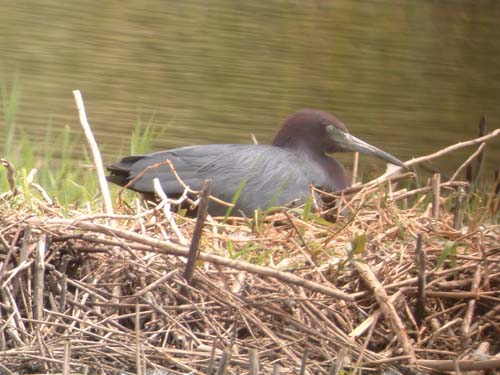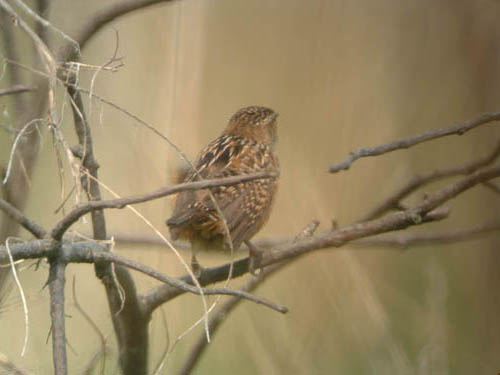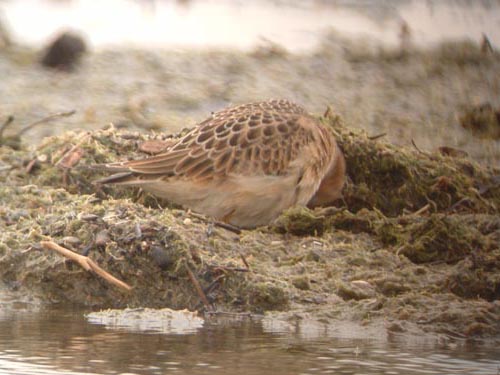ABA Photo Quiz
This photo quiz appeared in the January/February 2006 (Volume 38, Number 1) issue of Birding magazine, the bimonthly publication of the American Birding Association. I took the photos and wrote the discussions for all three quizzes below. The editors at Birding made a few minor grammatical changes to the text. Otherwise everything is the same. All three photos were taken with my Questar telescope and Fujifilm A303 digital camera, a technique known as digiscoping. To read about how I digiscope, see the Digiscoping with a Questar page on this Web site.
Note: Clicking a photo will reveal the answer above.
Discussion, Quiz Bird 1
This bird is sitting so we can't see the legs or the underparts below the neck. We can see that the body is fairly uniform in color and unpatterned and that the bill looks long and sharply pointed.
The pointed bill might suggest a loon or grebe but the bill is too long for any loon or grebe, and the uniform dark body color doesn't look right for a loon or grebe either.
Anhinga has a sharply pointed yellow bill, unlike the grayish based bill of our quiz bird. Anhinga also has a very long tail and conspicuous white markings on the back and wings.
Cormorants, frigatebirds, pelicans, and tubenoses have hooked bills.
Northern Gannet and the boobies do have bills that taper to a point but their bills are shorter and thicker than the bill of our quiz bird.
Plegadis ibises are dark overall but they have strongly decurved bills.
Storks have white bodies and heavier bills.
King, Clapper, and Virginia Rails have bills with some red color and streaked upperparts.
Cranes have shorter bills and a prominent "bustle" of feathers on the rear end.
Terns have bills that are either entirely black or have some red or yellow color.
The long, thick based bill tapering to a sharp point looks good for a heron of some kind, and the dark body color is typical of several members of this group. Great, Cattle, and Snowy Egrets are white or mostly white and can be eliminated from consideration right away. Immature Night-Herons have shorter, stouter bills and wing coverts that are streaked or spotted. American Bittern is brown in color and has streaking on the neck. Least Bittern has prominent buffy wing patches contrasting with a darker back. A Great Blue Heron would have black head plumes or a dark cap contrasting with a paler grayish body. The bluish upperparts of our quiz bird look good for a Tricolored Heron but Tricolored Heron has a whitish or pinkish stripe running along the center of the neck. Four of our herons are dark overall like our quiz bird: Green Heron, the dark morph of Reddish Egret, the dark morph of Western Reef Heron, and Little Blue Heron. Green Heron has rufous on the neck and pale edgings to the wing coverts. An adult dark morph Reddish Egret would have a sharply bicolored bill, pink on the inner half and black on the outer half. The bill of our quiz bird does look bicolored but the division between the light and dark areas is rather diffuse and the basal color looks gray, not pink. Also, the head and neck of an adult dark morph Reddish Egret would be rusty while the head and neck of our quiz bird look purplish. Immature Reddish Egrets have a largely dark bill and are a dingy gray overall. Though not illustrated in many North American field guides, Western Reef Heron has been recorded in the ABA area. The dark morph of the Western Reef Heron has a conspicuous white throat. The dark bluish color, purplish head and neck, and grayish based bill are however just right for an adult Little Blue Heron. This sitting Little Blue Heron was photographed by Robert D. Hughes on August 7, 2004 at Burnham Prairie in southern Cook County Illinois.
Discussion, Quiz Bird 2
This bird looks and feels like something small, an impression that is bolstered by the fact that said bird has short, thin legs. The bill and face are hidden but the upperparts are plainly visible, revealing a streaked crown, prominently streaked back, and finely barred wings. The tail is also visible and doesn't look particularly long. A number of small birds have prominent streaking on the back including pipits, Dendroica warblers, and sparrows, but fine barring on the wings (the actual wings, not the wing coverts) is typical of only one group of small perching birds, the wrens. Brown Creeper does have markings on the wings but these markings look more like wavy lines, not fine barring. Also, creepers are highly adapted to clinging to and climbing up trees, and though not impossible probably wouldn't be found perching on a branch like our quiz bird. Eastern and Western Meadowlarks also have fine barring on the wings but both species possess a pale median crown stripe and lack bold streaking on the back. Among the wrens only three species have streaking on the back: Cactus, Marsh, and Sedge Wren. Cactus Wren has a plain brown crown, unlike the streaked crown of our quiz bird. Marsh Wren also has an unstreaked brown crown and has clear rufous on the back. The streaked back and crown, finely barred wings, lack of rufous color on the back, and short tail identify our quiz bird as a Sedge Wren. This Sedge Wren was photographed by Robert D. Hughes on May 13, 2005 at Montrose Point in Chicago, Illinois.
Discussion, Quiz Bird 3
The dark upperpart feathers of this bird have narrow pale fringes, producing a pattern often described by birders as scaly. This scaly pattern is found in several different groups of birds but is especially prominent in juvenile jaegers, gulls, terns, and shorebirds. A few passerines also show this pattern. Juvenile jaegers have darker upperparts and barring on the sides and undertail coverts. Juvenile gulls and terns are generally whiter on the underparts and have longer wings, extending well past the tip of the tail; the tip of the longest primary on our quiz bird falls just about even with the tip of the tail. The warm overall color might suggest a Sprague's Pipit but a Sprague's Pipit would have a longer tail and noticeable wingbars. Several juvenile Ammodromus sparrows, particulary Baird's and Grasshopper Sparrows, have scaly upperparts but both species have longer tails and would show some streaking on the sides, unlike the plain sides of our quiz bird.
That leaves juvenile shorebirds to consider. Juvenile Charadrius plovers have scaly upperparts but are white below and possess a dark breastband or dark markings on the sides of the breast. Most of the other juvenile shorebirds have some rufous coloration in the upperparts. The upperparts of our quiz bird are whitish or buffy, completely lacking rufous tones. This lack of rufous eliminates Ruddy Turnstone, most Calidris sandpipers, both dowitchers, and all three phalaropes. Red Knot has gray upperparts with paler centers to the upperpart feathers. Great Knot is largely black and white in color. Upland Sandpiper has barring on the sides and a tail that extends beyond the folded primaries. Curlew Sandpiper is white below and has well-defined anchor shaped marks on the scapulars. Purple and Rock Sandpipers are darker overall and have spotting on the sides. Stilt Sandpiper is white on the underparts and has streaking on the sides. Semipalmated Sandpiper has a shorter primary projection beyond the tertials and is colder in color.The scaly upperparts might recall a Baird's Sandpiper but a Baird's Sandpiper would have a dark breastband contrasting with white underparts; the breast and underparts of our quiz bird look fairly uniform without any areas of strong contrast. A Baird's Sandpiper would also have folded primaries extending beyond the tip of the tail. There are two juvenile shorebirds that match the warm color and scaly upperpart pattern of our quiz bird, Ruff and Buff-breasted Sandpiper. Ruff is larger than Buff-breasted Sandpiper but this difference is hard to discern on a lone bird in a photograph. The rear end appears long and attenuated, favoring Buff-breasted. Also, the primary projection beyond the tertials seems too long for a Ruff. Finally, the fringes to the upperparts of our quiz bird are narrow while the same fringes to the upperparts of a Ruff would be broader. The warm overall color, scaly upperparts, plain, unmarked underparts, and attenuated rear end identify this bird as a juvenile Buff-breasted Sandpiper. This juvenile Buff-breasted Sandpiper was photographed by Robert D. Hughes on August 17, 2004 at Montrose Beach in Chicago, Illinois.


